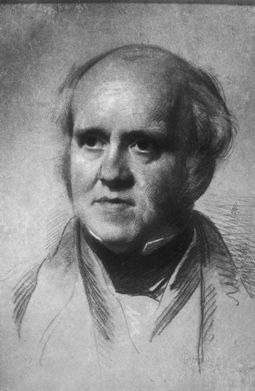
Patrick Corbett (Heriot-Watt University) recently took part in the Society’s Chartership programme as a scrutineer. Interestingly, the Society had chosen to host the meeting in the Leonard Horner Hall at Heriot-Watt University ….
Geoscientist 20.4 April 2010
Leonard Horner entered Edinburgh in 1799 at the age of 14 and learned, among other subjects, mineralogy - which stimulated a lifetime interest in geology. After leaving university he spent a quarter of a century as a linen merchant, travelling extensively and keeping up his intellectual interests. During this time became a fellow of the Geological Society (in the second year of its existence, 1808), was Secretary (1810-14) and twice President (1845-46, 1860-61). His first paper to the society was “On the mineralogy of the Malvern Hills”. In 1835 he helped initiate the Geological Survey of Great Britain. In his obituary W.J Hamilton, then President, recorded that Horner possessed a “cautious manner in which he avoids a too hasty generalisation” and concluded that he had laid the foundation of the principles that Murchison and Sedgwick subsequently applied to understanding the Palaeozoic rocks. Charles Lyell was obviously influenced by Horner, as the former married the latter’s daughter, Mary. He did much to promote a wider public interest in geology. After he retired as “the Inspector General of Factories” at age 74 in 1859, in the five years before his death, he spent time rearranging and cataloguing the Society’s museum collection.
In 1821, Horner founded the Edinburgh School of Arts (the first ever Mechanics’ Institute – for training skilled artisans) to promote high academic standards for the élite while extending useful knowledge to the labouring classes. Its prospectus stated the objectives “for the purpose of enabling industrious Tradesman to become acquainted with such principles of mechanics, chemistry and other branches of science as are of practical application in several trades”. Classes were held in the evening and included mineralogy for tradesmen working in the textiles industry for use in dye-making.
Karl Marx admired the work of Horner as a reforming factory inspector and eulogised that “his services to the English working classes will never be forgotten. He carried on a life-long contest, not only with the embittered manufacturers, but also with the cabinet”. In 1827, Horner was also invited to be the warden of the new University of London. He was effectively both Vice-chancellor (Principal) and Secretary of the new University. From this position of patronage, he was able to invite Charles Lyell to the chair of mineralogy at King’s College London in 1828.
The Edinburgh College of Arts was the progenitor institution from which Heriot-Watt University was created in 1966. Today the University retains the ethos of teaching practical subjects in a way that people in industry can participate, through international distance learning programmes – very much in the style of Leonard Horner – one of the founding fathers. I suspect Leonard Horner would have approved of the idea of professionalism (which is now embedded in Chartership and rather more evidence-based than in his day!) and the need for Continuing Professional Development .
Further reading
O’Farrell, P.N., 2004
Heriot-Watt University, An Illustrated History, Pearson Education, 511pp. Watch out for Patrick’s next book, a biography of Leonard Horner, the research for which has involved him in many happy hours in the Burlington House Library.
- If the past is the key to your present interests, why not join the History of Geology Group (HOGG)? For more information and to read the latest HOGG newsletter, visit the HOGG website at: www.geolsoc.org.uk/hogg.]